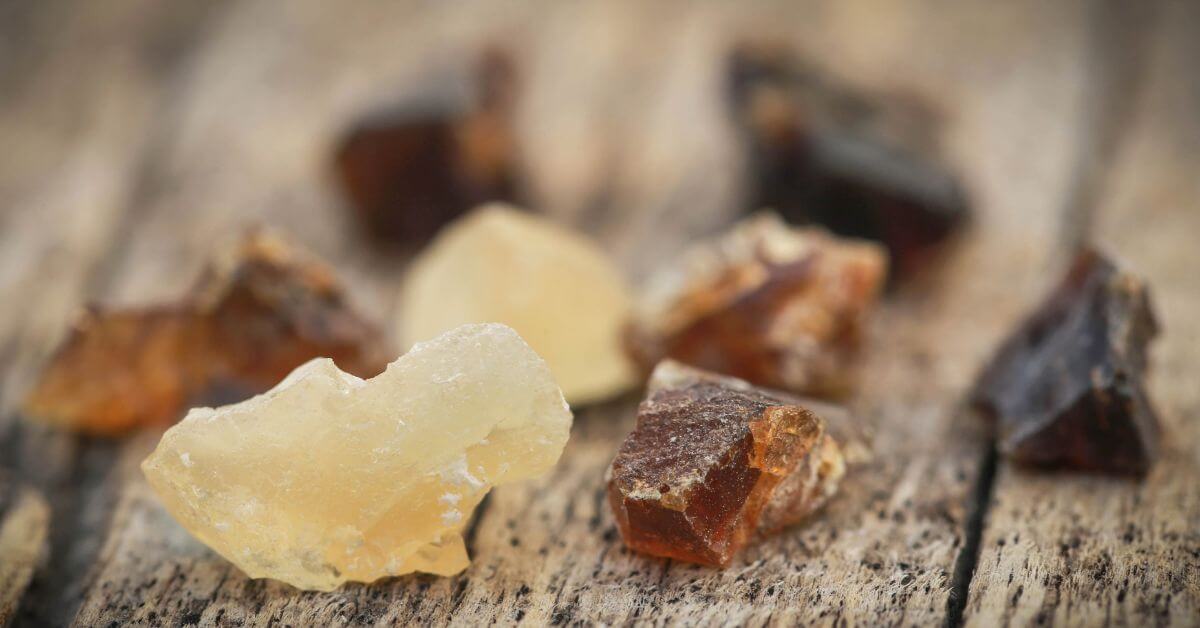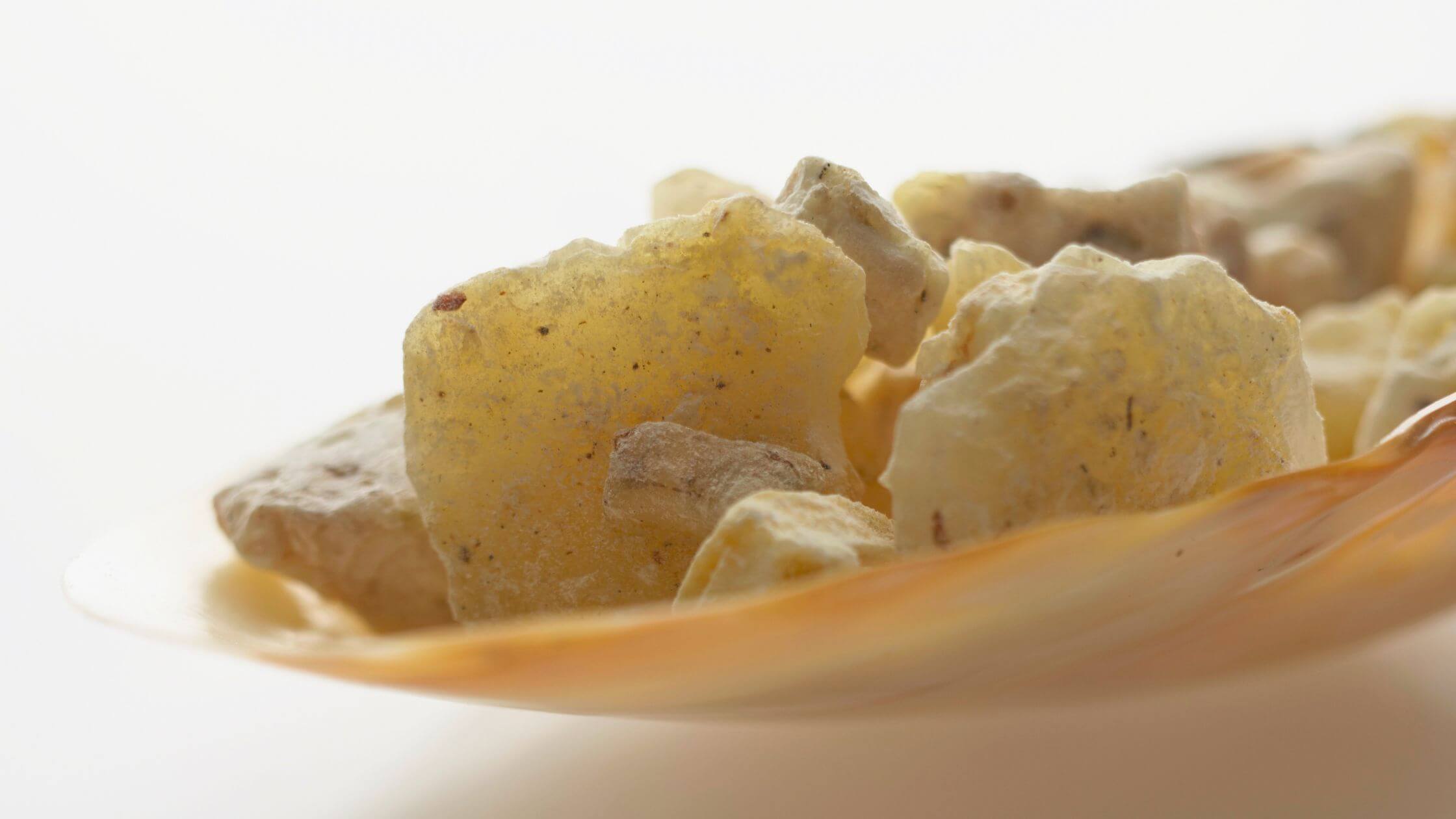Frankincense and Myrrh, two of the world’s oldest and most celebrated aromatic resins, have captured the human imagination for thousands of years. Originating from the hardened sap of specific trees found in Africa and the Middle East, these two treasured substances have been deeply woven into the religious, cultural, and medicinal fabric of numerous societies. From their role as precious commodities that fueled the trade routes of antiquity, to their sacred inclusion in religious ceremonies, Frankincense and Myrrh have been revered not only for their distinct and intoxicating aromas but also for their purported health and spiritual benefits.
In this exploration, we will journey through time, tracing the enduring legacy of Frankincense and Myrrh from ancient scriptures to modern holistic health practices, revealing why these resins continue to be held in such high regard to this day. Whether they are burned as incense in a sacred ritual, used as an essential oil for meditative practices, or applied as part of a skincare regimen, Frankincense and Myrrh are indeed timeless gifts from nature that continue to enrich our lives in myriad ways.
The Ancient Origins of Frankincense and Myrrh
significance in ancient civilizations.
Frankincense and Myrrh, two names that reverberate with the echoes of ancient civilizations, have played pivotal roles throughout history. The trees from which these sacred resins are harvested, Boswellia and Commiphora respectively, are native to the arid regions of the Arabian Peninsula, the Horn of Africa, and parts of India. But it wasn’t just the rarity of these trees that made their resins so valuable; it was the myriad of applications and the cultural reverence they commanded.
Cultural and religious importance in early scriptures
In ancient Egypt, Frankincense and Myrrh were considered indispensable for religious ceremonies and embalming processes. These resins, when burned, produced a fragrant smoke believed to connect the mortal world to the divine, acting as a medium to carry prayers to the gods. This ritualistic use was not exclusive to the Egyptians; the early Jewish temples also utilized these resins in their ceremonies, a practice that has been well documented in the Hebrew Bible.
The religious importance of Frankincense and Myrrh extended to early Christian scriptures as well. One of the most emblematic mentions is in the Nativity story of the New Testament, where the Three Wise Men presented baby Jesus with gifts of gold, frankincense, and myrrh—each carrying profound symbolic meaning.
But beyond religious rites, Frankincense and Myrrh seeped into the cultural tapestries of ancient societies. They were symbols of luxury and were often given as esteemed gifts to monarchs and nobility. Moreover, their alleged medicinal properties made them valuable commodities in ancient therapeutic practices.
As we trace the annals of history, the narrative of Frankincense and Myrrh unfolds as one of reverence, mysticism, and tradition. These resins were not just mere trade commodities; they were the essence of ancient rituals, the aroma of sacred spaces, and the scent that, to this day, evokes a sense of wonder and nostalgia.
Distinctive Properties of Frankincense and Myrrh
Delving into the world of aromatic resins, Frankincense and Myrrh stand out, each boasting its unique properties and characteristics. While they share a historical and cultural camaraderie, they stem from different botanical sources and possess distinct sensory profiles.
The Botanical Sources and Harvesting Processes
Frankincense is derived from the Boswellia trees, particularly the Boswellia sacra species. These trees thrive in the arid regions of the Arabian Peninsula, parts of Africa, and India. The resin is harvested by making incisions in the bark, allowing the milky-white sap to ooze out. Upon exposure to air, this sap hardens into resin beads or “tears.”
Myrrh, on the other hand, originates from the Commiphora species of trees, particularly Commiphora myrrha. These trees flourish in similar regions as the Boswellia trees. The harvesting process for Myrrh is akin to that of Frankincense, involving strategic cuts in the tree’s bark to extract the resin. However, the sap of Myrrh appears more reddish-brown and tends to be stickier.
Differences in Scent, Texture, and Appearance
At a glance, both resins might appear somewhat similar—gum-like nuggets varying in size. But upon closer inspection, the differences become evident.
Frankincense tears are often translucent with a slight amber hue and can range from small granules to larger chunks. When burned or heated, Frankincense releases a sweet, citrusy aroma with subtle pine undertones— a fragrance that evokes feelings of tranquility and spirituality. The resin’s texture is somewhat brittle and can easily be crushed into a fine powder.
Myrrh, in contrast, showcases a more opaque, deep reddish-brown appearance. Its scent is markedly different from Frankincense. When burned, Myrrh emanates a rich, smoky aroma with hints of balsamic sweetness. The resin’s texture is more tenacious than that of Frankincense, and it tends to be stickier to the touch.
In essence, while Frankincense and Myrrh share the limelight in ancient texts and rituals, their individual properties make them stand out. Their unique botanical origins, harvesting nuances, and sensory profiles offer a captivating glimpse into why these resins have been treasured for eons.
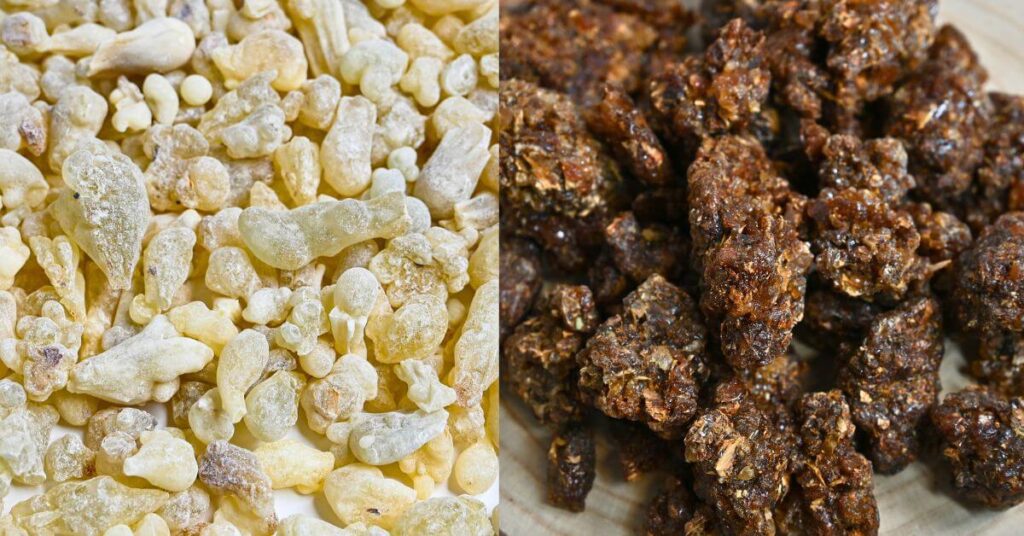

Frankincense and Myrrh
Resin Incense
Frankincense and Myrrh in Traditional Medicine
Frankincense and Myrrh, besides their storied religious and cultural significance, have long been esteemed for their medicinal attributes. From the dusty scrolls of ancient Egyptian papyrus to the scrolls of traditional Chinese medicine, these resins have found mention as remedies for a myriad of ailments. Their versatility in healing, both physically and spiritually, has made them indispensable in the annals of traditional medicine.
Their Role in Ancient Medicinal Practices Across Cultures
In Ancient Egypt, Frankincense and Myrrh were not just limited to mummification and rituals. They were part of the daily pharmacopeia, utilized for treatments ranging from wounds and infections to anti-aging concoctions. Myrrh, in particular, was celebrated for its antiseptic properties and was commonly used in poultices for wounds.
In Ancient China, Myrrh, known as “Mo Yao”, and Frankincense, termed “Ru Xiang”, were revered in the practice of traditional Chinese medicine. They were often prescribed, either separately or in combination, to stimulate blood circulation, reduce inflammation, and alleviate pain, especially for conditions related to trauma or arthritis.
The Ancient Greeks and Romans too acknowledged the medicinal prowess of these resins. Greek soldiers, as documented by the ancient physician Dioscorides, often carried Myrrh into battlefields, applying its resin to soothe and heal wounds.
Contemporary Research Backing Their Health Benefits
Modern science, with its analytical tools and methodologies, has begun to validate what ancient civilizations intuitively knew.
Recent studies on Frankincense have spotlighted its potential anti-inflammatory and analgesic properties. Boswellic acid, a primary component in Frankincense, has shown promise in managing inflammatory conditions like arthritis. Additionally, preliminary research hints at the potential role of Frankincense in supporting cognitive health and even combating certain types of cancers.
Myrrh, rich in compounds like furanoeudesma-1,3-diene and curzerene, has demonstrated potential antimicrobial and analgesic effects. Contemporary research has also highlighted its potential benefits in supporting oral health, with some studies indicating its efficacy in combating harmful oral bacteria.
While much remains to be explored about the full spectrum of their therapeutic properties, it is undeniable that Frankincense and Myrrh have etched their mark in the realm of holistic health, bridging the wisdom of ancient civilizations with the scientific rigor of the modern world.


meditation with frankincense and myrrh incense stick
Spiritual Significance of Frankincense and Myrrh
The aromas of Frankincense and Myrrh, transcending time and space, have often wafted through sacred halls, temples, and places of worship. Beyond their tangible attributes, these resins have deeply embedded spiritual symbolism, making them integral to various religious rituals and narratives across millennia.
Use in Religious Rituals and Ceremonies
From the ancient ziggurats of Mesopotamia to the echoing chambers of Egyptian temples, the scent of burning Frankincense and Myrrh has been synonymous with divine connection. Their smoke, rising heavenwards, symbolized prayers and offerings ascending to deities.
In Jewish tradition, the sacred incense used in the Tabernacle and later, the Temple in Jerusalem, contained Frankincense. It was burned on the golden altar daily, acting as an aromatic intermediary between the earthly realm and the divine.
Christian liturgy also embraced these resins. The Catholic Church, in particular, has a longstanding tradition of using Frankincense in censers during Mass, symbolizing prayers rising to God and the presence of the Holy Spirit.
Further East, in the ancient temples of China and India, Myrrh, recognized for its purifying qualities, was often incorporated in rituals to cleanse sacred spaces and as an offering to deities.
The Symbolism Behind Their Offerings in Sacred Texts
Possibly the most iconic mention of Frankincense and Myrrh is in the Christian nativity narrative. When the Magi, or the Wise Men, visited the infant Jesus, they brought gifts of gold, Frankincense, and Myrrh. Theologically, these gifts held deep symbolic meanings. While gold represented royalty, signifying Jesus’ kingship, Frankincense, often associated with divinity, symbolized his divine nature and priestly role. Myrrh, used in burial rites, prophetically pointed to his eventual suffering and death.
In other religious texts, Frankincense and Myrrh often represent purification, and intercession. In the Jewish Tanakh, for instance, Frankincense is mentioned as part of the meal offering, a sweet aroma pleasing to Yahweh.
In essence, the spiritual tapestry woven around Frankincense and Myrrh is intricate and profound. Whether as tools for divine communion, symbols of deep theological truths, or as sanctifiers of sacred spaces, these resins have ceaselessly bridged the gap between the human and the divine, the mortal and the eternal.
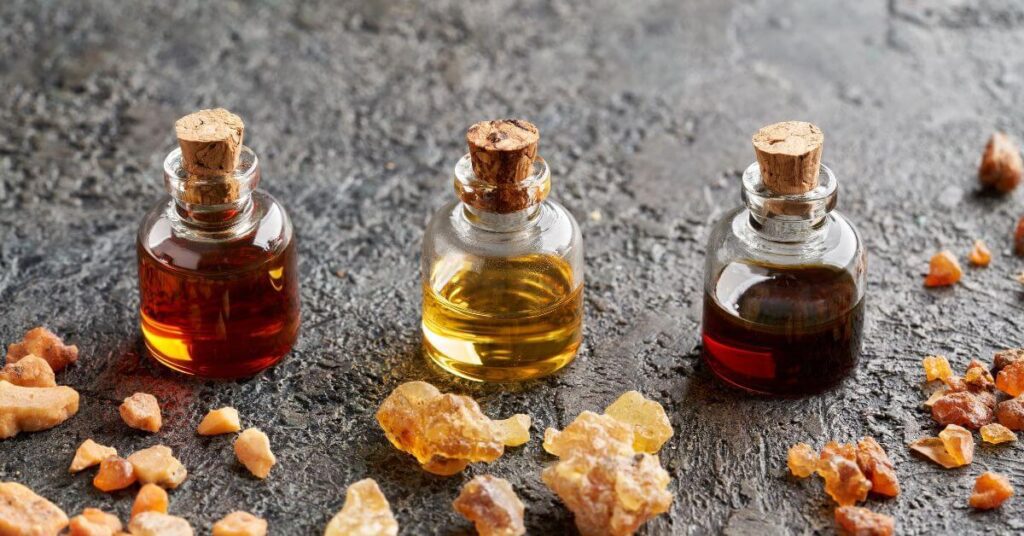

frankincense and myrrh essential oil
Modern Uses of Frankincense and Myrrh in Wellness
While Frankincense and Myrrh might be steeped in ancient lore, their significance in contemporary wellness practices is undiminished. Modern holistic therapies and aromatherapy have embraced these sacred resins, acknowledging their time-honored benefits and adapting them for today’s health-conscious individuals.
Their Role in Today’s Holistic Therapies and Aromatherapy
Holistic Therapies: As the world shifts towards a more integrated approach to health, Frankincense and Myrrh have found their niche. Many holistic therapists recommend these resins for their potential anti-inflammatory and analgesic properties. They are often incorporated into massage oils and balms to soothe muscle tension, alleviate joint pain, and promote skin health.
Aromatherapy: This therapeutic modality, which harnesses the power of plant aromas to promote well-being, has firmly positioned Frankincense and Myrrh in its repertoire. Essential oils derived from these resins are staples in many aromatherapy practices. Their rich, grounding scents are believed to help balance the mind, reduce anxiety, and foster a deep sense of tranquility.
Benefits for Well-being and Relaxation
The mental health benefits associated with Frankincense and Myrrh are as rich as their aromatic profiles. Here’s how they make a difference:
- Stress Reduction: In our fast-paced world, the calming scents of Frankincense and Myrrh essential oils can act as a balm for frazzled nerves. When diffused, their aromas can create a serene environment conducive to relaxation and stress relief.
- Mood Enhancement: Preliminary studies suggest that Frankincense, in particular, might have mood-lifting properties. Its ability to possibly influence the production of certain neurotransmitters makes it a favorite for those dealing with mood imbalances.
- Meditative Aid: For those who practice meditation or deep relaxation exercises, the scent of these resins can enhance the experience. Their grounding aromas aid in pulling one into the present moment, deepening focus and promoting a meditative state.
- Sleep Aid: Myrrh, with its slightly sedative properties, can be beneficial for those struggling with sleep issues. When blended with other calming oils and diffused in the bedroom, it can set the stage for a restful night.
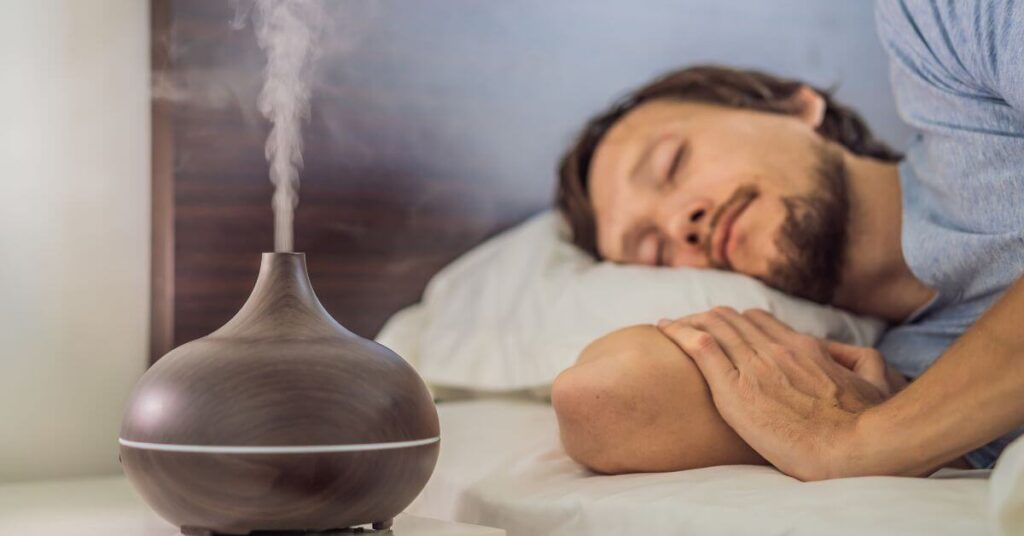

Frankincense and myrrh as sleeping aid
In sum, the modern resurgence of Frankincense and Myrrh in wellness is a testament to their timeless appeal and multifaceted benefits. From skin salves to diffuser blends, these resins continue to soothe, heal, and uplift, proving that ancient wisdom still holds profound relevance in our contemporary world.
Safeguarding the Legacy: Conservation of Frankincense and Myrrh Trees
The fragrant gifts of Frankincense and Myrrh have enchanted civilizations for centuries. Yet, like many treasures of the natural world, the trees that produce these precious resins are facing mounting challenges. As we revel in the wonders of these age-old resins, it becomes imperative to address the looming threats and be proactive in their conservation.
The Threats Facing the Trees Producing These Resins
- Over-harvesting: The increasing global demand for Frankincense and Myrrh has led to aggressive tapping methods. Over-harvesting can weaken the trees, making them susceptible to diseases and ultimately, drastically reducing resin output.
- Land Conversion: Expansion of agricultural lands, especially in areas like the Horn of Africa where many of these trees are native, threatens their very existence. As more land gets converted for farming or urbanization, the natural habitats of these trees shrink.
- Climate Change: The delicate balance of the ecosystems where Frankincense and Myrrh trees thrive is at risk due to changing weather patterns. Extended droughts or altered rainfall patterns can impact their growth and resin production.
- Pests and Diseases: Over-harvesting, coupled with the impacts of climate change, make these trees more vulnerable to pests and diseases, which can decimate entire populations.
Initiatives and Practices Ensuring Sustainable Harvesting
- Community Training: Many NGOs and environmental organizations are working closely with local communities to educate them about sustainable harvesting techniques. By making minimal incisions and allowing trees adequate recovery time, the long-term health of these trees can be ensured.
- Certifications: There are now certification bodies that validate ethically and sustainably sourced Frankincense and Myrrh. By supporting brands and products with these certifications, consumers can play a part in promoting sustainable practices.
- Reforestation Efforts: Recognizing the threats facing these trees, many regions have undertaken reforestation projects. Planting new trees and ensuring their survival is critical to the long-term availability of these cherished resins.
- Research and Development: Scientists and researchers are delving into ways to increase resin yield without stressing the trees, ensuring both quality and quantity are maintained.
- Supporting Local Communities: Ensuring that communities who traditionally rely on these trees for their livelihood benefit from their conservation is essential. By providing them with fair wages and empowering them with skills and knowledge, their commitment to the trees’ welfare is strengthened.
As the narrative of Frankincense and Myrrh continues to unfold, intertwining ancient traditions with modern needs, the onus lies on us to ensure that this story doesn’t have a tragic ending. With mindful consumption, support for sustainable practices, and a shared reverence for the trees that gift us these resins, we can ensure that their legacy remains untarnished for generations to come.
Conclusion
In the annals of time, few resins have captured the imagination, reverence, and utility as Frankincense and Myrrh. From the mystical chambers of ancient temples to the tranquil corners of modern spas, their fragrant footprints are omnipresent. These resins, suffused with spiritual gravitas and medicinal prowess, are not just relics of bygone eras but remain relevant touchstones in our contemporary world.
Their importance in shaping cultural narratives and wellness traditions underscores a shared human heritage—one that recognizes the profound power of nature’s bounty. And as we lean into the future, the call for their preservation and sustainable utilization grows even louder. After all, Frankincense and Myrrh are not just aromatic resins; they are aromatic testaments to our shared history, holistic health, and the enduring dance between nature and mankind.
In cherishing and safeguarding these sacred resins, we pay homage to our ancestors, acknowledge the gifts of the present, and pave the way for a fragrant, enriched future. The story of Frankincense and Myrrh is an ongoing saga, and it beckons us to ensure its chapters are filled with reverence, wisdom, and sustainable practices.
